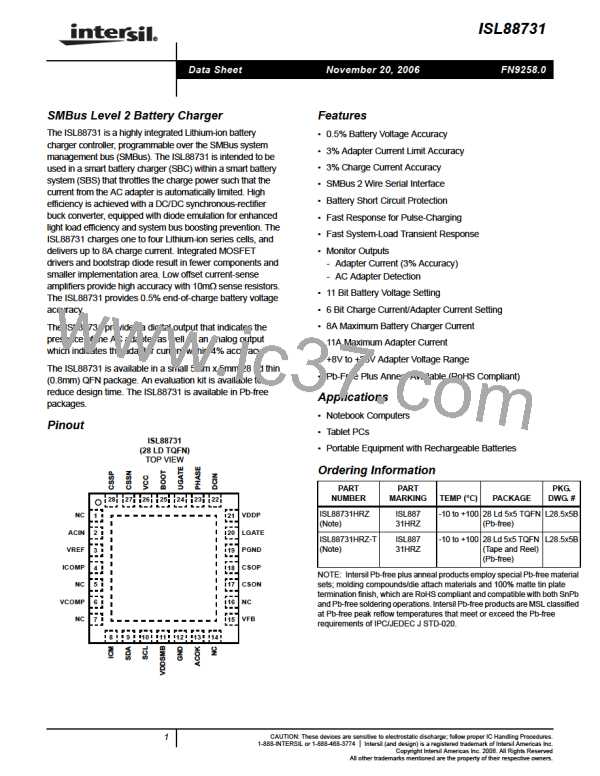ISL88731
Acknowledges by holding SDA low during the 9th clock pulse.
Charger Timeout
ISL88731 then sends the higher byte stored in the register.
After the second byte neither device holds SDA low (No
Acknowledge). The master will then produce a Stop condition
to end the read transaction.
The ISL88731 includes 2 timers to insure the SMBus master
is active and to prevent over charging the battery. ISL88731
will terminate charging if the charger has not received a write
to the ChargeVoltage or ChargeCurrent register within 175s
or if the SCL line is low for more than 25ms. If a time-out
occurs, either ChargeVoltage or ChargeCurrent registers
must be written to re-enable charging.
ISL88731 does not support reading more than 1 register per
transaction.
Application Information
ISL88731 Data Byte Order
The following battery charger design refers to the “TYPICAL
APPLICATION CIRCUIT” on page 2, where typical battery
configuration of 3S2P is used. This section describes how to
select the external components including the inductor, input
and output capacitors, switching MOSFETs and current
sensing resistors.
Each register in ISL88731 contains 16-bits or 2, 8 bit bytes.
All data sent on the SMBus is in 8 bit bytes and 2 bytes must
be written or read from each register in ISL88731. The order
in which these bytes are transmitted appears reversed from
the way they are normally written. The LOW byte is sent first
and the HI byte is sent second. For example, When writing
0x41A0, 0xA0 is written first and 0x41 is sent second.
Inductor Selection
The inductor selection has trade-offs between cost, size,
cross over frequency and efficiency. For example, the lower
the inductance, the smaller the size, but ripple current is
higher. This also results in higher AC losses in the magnetic
core and the windings, which decreases the system
Writing to the Internal Registers
In order to set the charge current, charge voltage or input
current, valid 16-bit numbers must be written to ISL88731’s
internal registers via the SMBus.
efficiency. On the other hand, the higher inductance results
in lower ripple current and smaller output filter capacitors,
but it has higher DCR (DC resistance of the inductor) loss,
lower saturation current and has slower transient response.
So, the practical inductor design is based on the inductor
ripple current being ±15% to ±20% of the maximum
To write to a register in the ISL88731, the master sends a
control byte with the R/W bit set to 0, indicating a write. If it
receives an Acknowledge from the ISL88731 it sends a
register address byte setting the register to be written (i.e.
0x14 for the ChargeCurrent register). The ISL88731 will
respond with an Acknowledge. The master then sends the
lower data byte to be written into the desired register. The
ISL88731 will respond with an Acknowledge. The master
then sends the higher data byte to be written into the desired
register. The ISL88731 will respond with an Acknowledge.
The master then issues a Stop condition, indicating to the
ISL88731 that the current transaction is complete. Once this
transaction completes the ISL88731 will begin operating at
the new current or voltage.
operating DC current at maximum input voltage. Maximum
ripple is at 50% duty cycle or V
= V /2. The
BAT
IN,MAX
required inductance for ±15% ripple current can be
calculated from Equation 3:
V
IN, MAX
⋅ 0.3 ⋅ I
L, MAX
--------------------------------------------------------
L =
4 ⋅ F
(EQ. 3)
SW
Where V
switching frequency and I
inductor.
is the maximum input voltage, F
is the
IN,MAX
SW
is the max DC current in the
L,MAX
ISL88731 does not support writing more than one register
per transaction
For V
= 20V, V
BAT
= 12.6V, I
= 4.5A, and
BAT,MAX
IN,MAX
f = 400kHz, the calculated inductance is 9.3µH. Choosing
s
Reading from the Internal Registers
the closest standard value gives L = 10µH. Ferrite cores are
often the best choice since they are optimized at 400kHz to
600kHz operation with low core loss. The core must be large
The ISL88731 has the ability to read from 5 internal registers.
Prior to reading from an internal register, the master must first
select the desired register by writing to it and sending the
registers address byte. This process begins by the master
sending a control byte with the R/W bit set to 0, indicating a
write. Once it receives an Acknowledge from the ISL88731 it
sends a register address byte representing the internal
register it wants to read. The ISL88731 will respond with an
Acknowledge. The master must then respond with a Stop
condition. After the Stop condition the master follows with a
new Start condition, then sends a new control byte with the
ISL88731 slave address and the R/W bit set to 1, indicating a
read. The ISL88731 will Acknowledge then send the lower
byte stored in that register. After receiving the byte, the master
enough not to saturate at the peak inductor current I
Equation 4:
in
Peak
1
2
--
I
= I
+
⋅ I
RIPPLE
PEAK
L, MAX
(EQ. 4)
Inductor saturation can lead to cascade failures due to very
high currents. Conservative design limits the peak and RMS
current in the inductor to less than 90% of the rated
saturation current.
Cross over frequency is heavily dependent on the inductor
value. F
should be less than 20% of the switching
CO
frequency and a conservative design has F
less than
CO
FN9258.0
November 20, 2006
15

 INTERSIL [ Intersil ]
INTERSIL [ Intersil ]